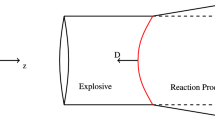Abstract
A Sympathetic detonation (SD) is a detonation of an explosive charge by a nearby explosion. Most of times it is unintended while the impact of blast fragments or strong shock waves from the initiating donor explosive is the cause of SD. We investigate the SD of a cylindrical explosive charge (64 % RDX, 20 % Al, 16 % HTPB) contained in a steel casing. The constitutive relations for high explosive are obtained from a thermo-chemical code that provides the size effect data without the rate stick data typically used for building the rate law and equation of state. A full size SD test of eight pallet-packaged artillery shells is performed that provides the pressure data while the hydrodynamic model with proper constitutive relations for reactive materials and the fragmentation model for steel casing is conducted to replicate the experimental findings. The work presents a novel effort to accurately model and reproduce the sympathetic detonation event with a reduced experimental effort.
Similar content being viewed by others
References
A. C. Victor, A simple method for calculating sympathetic detonation of cylindrical, cased explosive charges, Propellants, Explosives, Pyrotechnics, 21 (2) (1996) 90–99.
L. J. Lochert, M. D. Franson and B. L. Hamshere, Reduced sensitivity RDX (RS-RDX) Part II: Sympathetic reaction, DSTO-TR-1941, AR-013-794 (2006) 1–26.
G. Son, J. Park and S. Kim, A study on non-mass detonator, Journal of the Korea Society for Explosives and Blasting Engineering, 9 (2) (1991) 31–36.
S. D. Fisher, E. L. Baker, L. Wells, G. Quigley and A. Lew, XM982 Excalibur sympathetic detonation modeling and experimentation, Armament Research Center, IMEMG, Bristol (2006) 1–11.
L. Chen, C. Wang, C. Feng, F. Lu, J. Lu, X. Wang and X. Guo, Study on random initiation phenomenon for sympathetic detonation of explosive, Defence Technology, 9 (4) (2013) 224–228.
K. J. Benjamin and S. John, Simulating sympathetic detonation of 105-mm artillery projectiles with CTH, ARL-TR-1365, ADA32 6855 (1997) 1–35.
K. Kim, B. Kim and J. J. Yoh, A particle level-set based Eulerian method for simulating explosively driven metal pipe, 48th AIAA/ASME/SAE/ASEE Joint Propulsion Conference & Exhibit (2012) 1–17.
E. L. Lee, H. C. Hornig and J. W. Kury, Adiabatic expansion of high explosive detonation products, UCRL-50422, TID 4500 (1968) 1–21.
L. E. Fried, W. M. Howard and P. C. Souers, Cheetah 2.0 User’s Manual, UCRL-MA-117541 Rev. 5, Lawrence Livermore National Laboratory, Livermore, CA, USA (1998).
B. Kim, J. Park, K. Lee and J. J. Yoh, A reactive flow model for heavily aluminized cyclotrimethylene-trinitramine, Journal of Applied Physics, 116 (2) (2014) 1–9.
J. E. Guilkey, T. B. Harman and B. Banerjee, An Eulerian-Lagrangian approach for simulating explosions of energetic devices, Computers and Structures, 85 (2007) 660–674.
G. R. Johnson and W. H. Cook, Fracture characteristics of three metals subjected to various strains, strain rates, temperatures and pressures, Engineering Fracture Mechanics, 21 (1) (1985) 31–48.
N. F. Mott, Fragmentation of shell cases, Proceedings of the Royal Society of London (A), 189 (1018) (1947) 300–308.
Author information
Authors and Affiliations
Corresponding author
Additional information
Recommended by Associate Editor Won Gyu Shin
Jai-ick (Jack) Yoh is a Professor at Seoul National University. He received his Ph.D. in Theoretical & Applied Mechanics (Combustion) from UIUC and has worked for LLNL as a Staff Scientist prior to joining SNU. His research interests include combustion, energetics, and innovative laser applications.
Bohoon Kim is currently a Ph.D. candidate in Department of Mechanical and Aerospace Engineering at Seoul National University. His research interests include Reactive flow model for energetic materials and Shock to detonation transition analysis.
Minsung Kim is currently a M.S. candidate in Department of Mechanical and Aerospace Engineering at Seoul National University. His research interests are reactive flow model for energetic materials including deflagration analysis.
Rights and permissions
About this article
Cite this article
Kim, B., Kim, M., Sun, T. et al. Simulating sympathetic detonation using the hydrodynamic models and constitutive equations. J Mech Sci Technol 30, 5491–5502 (2016). https://doi.org/10.1007/s12206-016-1117-2
Received:
Revised:
Accepted:
Published:
Issue Date:
DOI: https://doi.org/10.1007/s12206-016-1117-2




